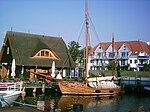Barther Oie
German islands in the BalticIslands of Mecklenburg-Western PomeraniaNature reserves in Mecklenburg-Western PomeraniaUninhabited islands of GermanyZingst

The uninhabited island of Barther Oie belongs to the German federal state of Mecklenburg-Vorpommern and lies in the lagoon of Barther Bodden, between the town of Barth and the Baltic seaside resort of Zingst. The Baltic Sea island has an area of about 850 by 800 metres (2,790 ft × 2,620 ft) and rises, like its sister island of Kirr, only 1 metre (3 ft 3 in) above sea level. Today the island is a nature reserve in the West Pomeranian Lagoon Area National Park.
Excerpt from the Wikipedia article Barther Oie (License: CC BY-SA 3.0, Authors, Images).Barther Oie
Geographical coordinates (GPS) Address Nearby Places Show on map
Geographical coordinates (GPS)
| Latitude | Longitude |
|---|---|
| N 54.408611111111 ° | E 12.727777777778 ° |
Address
Klein Kirr
18374
Mecklenburg-Vorpommern, Germany
Open on Google Maps









